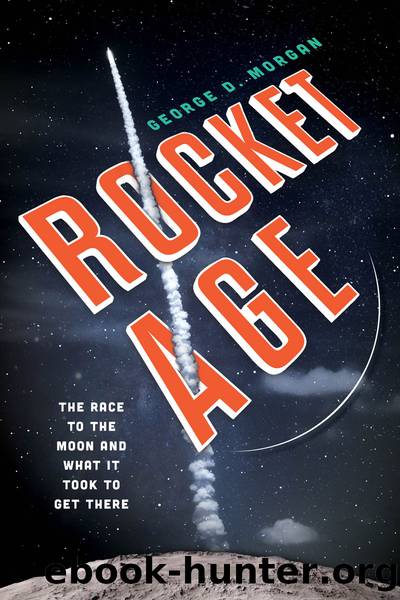Rocket Age by George D. Morgan

Author:George D. Morgan
Language: eng
Format: epub
Publisher: Prometheus
Published: 2020-03-19T00:00:00+00:00
19
EOR, LOR, AND LEM
One of the many things NASA operations . . . had in common with the military was that rest was a scarce commodity.
âGene Kranz
In the early days of the space program, as hardware design was first being conceptualized, engineers followed a model laid down early on by science fiction writers and movie companies. The world of entertainment envisioned Moon rockets that were tall, silver, sleek, and aerodynamic, with tapered nose cones and wide tail fins. They would descend to the lunar surface as a single vehicle, then later take off with their structure still fully intact. The astronauts inside the rocket would be strapped down to large, comfortable reclining seats as they fought against the forces of several gâs of acceleration. The rocket would then return to Earth looking the same as it did when it left the Moon. Such a scenario was seriously considered for a timeâso seriously that NASA even gave it a name, referring to it as âdirect descent.â Wernher von Braun had once exchanged his engineerâs cap for a writerâs in 1958, publishing a novella entitled First Men to the Moon. In the story a giant rocket, carrying several astronauts, launches a smaller rocket toward the Moon, which lands in one piece, then later takes off and returns to Earth in a single stage.1
It did not take long for reality to trump the fanciful imaginations of authors and filmmakers, and direct descent as a viable option was discarded. There were two aspects of landing on the Moon that made a direct descent spacecraft impractical, and far too expensive: the Moonâs much weaker gravity, and the lack of any atmosphere. Since there was no atmosphere, there was no need at all for a lunar-landing rocket to have a sleek aerodynamic design. A nose cone and fins would be superfluousâeven ridiculous. And utilizing the now well-understood benefits of staging, there was no reason not to leave part of the lunar landing ship behind. Anything that was used up and not needed for the return flight could be left on the Moon as dead weightâno reason to carry it home.
Disposing of the direct descent concept of lunar travel was all a violation of the romanticized vision of Moon and planetary landings served up by Jules Verne and Hollywoodâa fanciful image that had been around for decades by the time the 1960s arrived. But it was not just authors and filmmakers that promulgated that vision; they were assisted by the ultimate space seer himself, Wernher von Braun. A fully complete ship landing on the Moon and taking off again was what he had envisioned since boyhood.
Some spaceship of some sort would need to land on the Moon. But what would it look like? Or, more important, what should it look like? At first the engineers just referred to this future unknown ship as âthe lander.â Throughout its design phase, the lander went through many conceptual changes. Every pound that landed on the Moon was a pound that
Download
This site does not store any files on its server. We only index and link to content provided by other sites. Please contact the content providers to delete copyright contents if any and email us, we'll remove relevant links or contents immediately.
| Automotive | Engineering |
| Transportation |
Whiskies Galore by Ian Buxton(41526)
Introduction to Aircraft Design (Cambridge Aerospace Series) by John P. Fielding(32886)
Small Unmanned Fixed-wing Aircraft Design by Andrew J. Keane Andras Sobester James P. Scanlan & András Sóbester & James P. Scanlan(32571)
Craft Beer for the Homebrewer by Michael Agnew(17931)
Turbulence by E. J. Noyes(7698)
The Complete Stick Figure Physics Tutorials by Allen Sarah(7136)
Kaplan MCAT General Chemistry Review by Kaplan(6594)
The Thirst by Nesbo Jo(6433)
Bad Blood by John Carreyrou(6271)
Modelling of Convective Heat and Mass Transfer in Rotating Flows by Igor V. Shevchuk(6220)
Learning SQL by Alan Beaulieu(6033)
Weapons of Math Destruction by Cathy O'Neil(5825)
Man-made Catastrophes and Risk Information Concealment by Dmitry Chernov & Didier Sornette(5645)
Digital Minimalism by Cal Newport;(5389)
Life 3.0: Being Human in the Age of Artificial Intelligence by Tegmark Max(5183)
iGen by Jean M. Twenge(5159)
Secrets of Antigravity Propulsion: Tesla, UFOs, and Classified Aerospace Technology by Ph.D. Paul A. Laviolette(4985)
Design of Trajectory Optimization Approach for Space Maneuver Vehicle Skip Entry Problems by Runqi Chai & Al Savvaris & Antonios Tsourdos & Senchun Chai(4837)
Electronic Devices & Circuits by Jacob Millman & Christos C. Halkias(4745)
